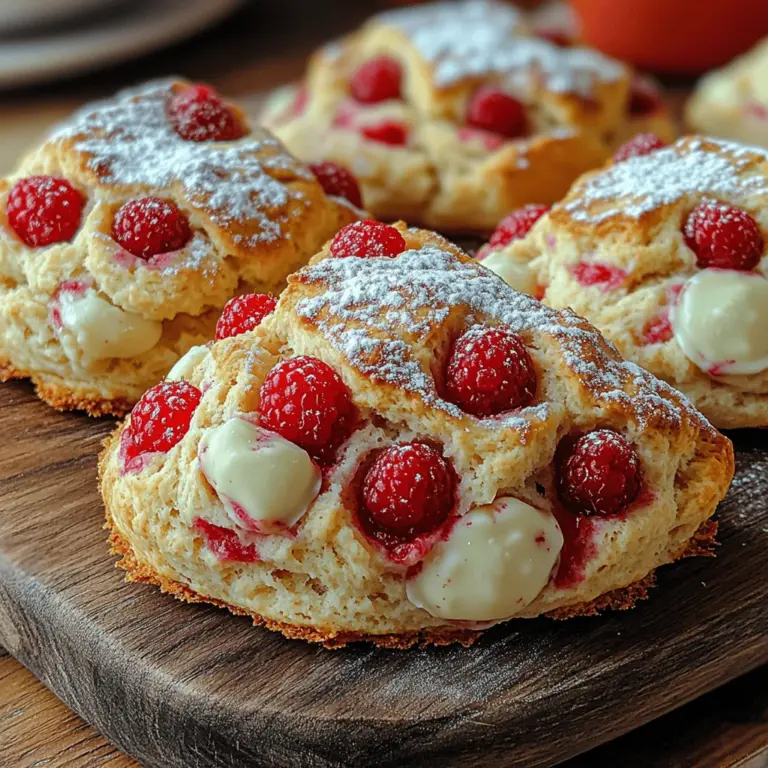Introduction
Scones are one of those delightful treats that have a unique ability to elevate any occasion. Whether served at a leisurely breakfast, an elegant tea party, or simply enjoyed with a cup of coffee, these baked goods are cherished for their flaky texture and subtle sweetness. Among the vast array of scone variations, the delicate raspberry white chocolate scones stand out as a truly decadent option. This unique flavor combination marries the tartness of fresh raspberries with the creamy sweetness of white chocolate, creating an indulgent experience that is hard to resist.
Using fresh ingredients is paramount when it comes to crafting the perfect scone. The quality of your raspberries and the richness of the white chocolate can significantly influence the final product. When made correctly, scones should be tender and crumbly with a hint of sweetness, making them an instant favorite for anyone who tries them. In this article, we will explore the history of scones, delve into the key ingredients that make our raspberry white chocolate scones so special, and provide you with a step-by-step guide to making them at home.
Understanding Scones: A Brief History
The origins of scones can be traced back to the British Isles, with various forms of the beloved baked good appearing in both Scotland and England. Traditionally, scones were made with a simple mixture of flour, baking powder, salt, and butter, often baked on a griddle or in a hot oven. The name “scone” is believed to have derived from the “Scone” stone in Scotland, where Scottish kings were crowned, symbolizing the treat’s historical significance.
Over the years, scone recipes have evolved, leading to a myriad of delicious variations. From plain scones to those studded with fruits, nuts, or spices, the versatility of this pastry has allowed it to adapt to different tastes and preferences. In contemporary baking, scones are often enjoyed during tea time, a cherished British tradition that encourages social gatherings and the enjoyment of sweet and savory treats alike. The combination of scones with clotted cream and jam epitomizes the classic afternoon tea experience, and our raspberry white chocolate scones fit perfectly into this delightful ritual.
Ingredients Breakdown
To create the perfect raspberry white chocolate scones, it’s essential to understand the purpose of each ingredient used in the recipe. Below is a detailed breakdown of the key components that contribute to the flavor, texture, and overall success of these delightful pastries.
All-Purpose Flour
All-purpose flour serves as the foundation of the scone dough, providing structure and stability. It is versatile and readily available, making it the go-to choice for scone recipes. For those seeking alternatives, options such as whole wheat flour or gluten-free flour blends can be used, but keep in mind that this may alter the texture and flavor of the final product.
Granulated Sugar
Sugar plays a dual role in our scone recipe. First, it adds sweetness, balancing the tartness of the raspberries. Second, it contributes to the overall texture, helping to create that desired crumbly consistency. Using granulated sugar will provide the right amount of sweetness without overpowering the other flavors.
Baking Powder
Baking powder is a crucial ingredient in scone-making, acting as a leavening agent that helps the scones rise. A proper amount of baking powder ensures that the scones achieve a light and airy texture, which is essential for a delightful eating experience. Be sure to check the expiration date of your baking powder to ensure maximum effectiveness.
Salt
While salt may seem like a minor ingredient, it plays a vital role in enhancing the overall flavor of the scones. A small amount of salt helps to balance the sweetness and bring out the natural flavors of the other ingredients. It’s important not to skip this step, as salt can elevate the taste of your baked goods significantly.
Unsalted Butter
Butter is an essential ingredient in scones, providing richness and flavor. For the best results, use cold unsalted butter, as this helps create a flaky texture when incorporated into the dough. Cold butter creates steam during baking, which contributes to the scone’s rise and flakiness. If you only have salted butter on hand, reduce the amount of added salt in the recipe.
Heavy Cream
Heavy cream adds moisture and richness to the scone dough, yielding a tender crumb. The fat content in heavy cream contributes to the overall texture, making the scones melt in your mouth. For a lighter alternative, you can substitute half and half or whole milk, but be aware that the texture may differ slightly.
Egg
The egg serves as a binding agent in the scone dough, helping to hold the ingredients together while providing added richness and color. When mixed into the dough, it enhances the overall structure, contributing to the scones’ delightful texture.
Vanilla Extract
A splash of vanilla extract introduces a depth of flavor to the scone dough, complementing the sweetness of the white chocolate and the tartness of the raspberries. High-quality pure vanilla extract is recommended for the best taste, as artificial alternatives may not provide the same level of flavor.
Raspberries
Fresh raspberries are the star of this recipe, bringing a burst of tartness that balances the sweetness of white chocolate. While fresh raspberries are preferred for their vibrant flavor and texture, frozen raspberries can also be used in a pinch. However, be cautious, as frozen berries may release more moisture during baking, potentially affecting the final texture of the scones. Raspberries are not only delicious but also packed with nutrients, providing a boost of vitamins and antioxidants.
White Chocolate Chips
White chocolate chips add a creamy sweetness that perfectly complements the tart raspberries. When selecting white chocolate, look for high-quality brands that contain cocoa butter for a smooth melting consistency. Avoid products labeled as “white confectionery” or “white coating,” as these often contain less cocoa butter and more additives, affecting the overall flavor of your scones.
Egg Wash
An egg wash, made from a whisked egg and a splash of water or milk, is brushed on the scones before baking. This gives the scones a beautiful golden-brown color and a glossy finish, enhancing their visual appeal. Skipping the egg wash will result in scones that lack the enticing sheen and rich color.
Extra Sugar
Sprinkling a little extra sugar on top of the scones before baking adds a delightful sweet crunch to the finished product. This small touch elevates the scones visually and makes them even more inviting to enjoy.
Step-by-Step Guide to Making Raspberry White Chocolate Scones
Preheating the Oven
Before diving into the mixing and kneading of ingredients, it’s crucial to preheat your oven. Setting the correct temperature ensures that the scones bake evenly and achieve the desired texture. For our raspberry white chocolate scones, preheat your oven to 400°F (200°C). This hot environment will create steam, causing the scones to rise beautifully while developing a lovely golden crust on the outside.
Once your oven reaches the desired temperature, you can begin preparing the scone dough, ensuring that you maximize the freshness and quality of your ingredients.
—
As you continue your journey to create these delicate raspberry white chocolate scones, each step will bring you closer to a delightful treat that is sure to impress. Stay tuned for the next part of the article, where we will delve into the detailed instructions for mixing, shaping, and baking your scones to perfection.

Mixing Dry Ingredients: Achieving the Right Consistency
To achieve perfectly tender Raspberry White Chocolate Scones, the first step is mixing the dry ingredients. Begin by combining all-purpose flour, baking powder, and a pinch of salt in a large mixing bowl. Using a whisk, blend these ingredients thoroughly to ensure even distribution of the baking powder, which is crucial for proper rising. Aim for a light, airy consistency; this will help create soft scones that are not dense or heavy. If you’re feeling adventurous, consider adding a tablespoon of cornstarch to the flour mixture. This will help create a tender crumb by inhibiting gluten development.
Cutting in Butter: Techniques for the Perfect Crumb
The next step involves cutting in the butter, a critical process for achieving that flaky texture characteristic of scones. Start with cold, unsalted butter, cut into small cubes for easier incorporation. Using a pastry cutter or your fingertips, blend the butter into the flour mixture until it resembles coarse crumbs with some pea-sized bits of butter remaining. This technique is essential; the small chunks of butter, when melted during baking, will create steam that contributes to the scone’s flaky layers. Be careful not to overwork the dough, as this can lead to tough scones.
Combining Wet Ingredients: Ensuring a Uniform Mixture
Now that your dry ingredients are ready, it’s time to combine the wet ingredients. In a separate bowl, whisk together heavy cream, an egg, and a splash of vanilla extract. The cream adds richness, while the egg provides structure. Pour this mixture into the bowl with the dry ingredients and use a spatula to gently fold until just combined. It’s important not to overmix at this stage; a few dry spots are okay. The goal is to hydrate the flour without activating too much gluten, which could make the scones dense.
Folding in Add-Ins: Techniques for Preserving Raspberry Integrity
Once your dough is formed, it’s time to incorporate the star ingredients: fresh raspberries and white chocolate chips. Gently fold in the raspberries and chocolate, taking care not to crush the delicate berries. This can be done by using a spatula to lift the dough from the bottom of the bowl and folding it over the add-ins rather than stirring vigorously. This method helps maintain the shape of the raspberries, ensuring they remain intact during baking and provide bursts of flavor in each bite.
Shaping the Dough: Tips for Uniform Scone Sizes
After the add-ins are incorporated, transfer the dough onto a floured surface. Gently pat the dough into a circle about 1-inch thick. Use a sharp knife or a bench scraper to cut the dough into wedges or use a round cutter for traditional scone shapes. The key to uniform scone sizes is to ensure that each piece is cut evenly without twisting the cutter, which can seal the edges and prevent proper rising. Once shaped, place the scones on a parchment-lined baking sheet, ensuring there’s enough space between each one for even baking.
Transferring to Baking Sheet: Spacing and Arrangement for Even Baking
When transferring your scones to the baking sheet, maintain at least 1-2 inches of space between each piece. This spacing is essential for allowing the heat to circulate properly, which promotes even baking and prevents the scones from sticking together. If you prefer a more rustic look, you can arrange the scones closer together; they will bake together and create a lovely, soft edge. Before baking, brush the tops with a little additional heavy cream or an egg wash for a beautiful golden finish.
Baking Process: Signs of Doneness and Achieving That Golden Brown
Preheat your oven to 400°F (200°C) and bake the scones for 15-20 minutes. Keep an eye on them as they bake; they should puff up nicely and turn a lovely golden brown. A toothpick inserted in the center should come out clean, with just a few crumbs attached. If you prefer your scones slightly softer, remove them from the oven when they are lightly golden; for a crisper texture, leave them in for an additional minute or two. Once baked, allow them to cool slightly on the baking sheet before transferring them to a wire rack.
Cooling and Serving: Suggestions for Presentation and Pairing
For the best flavor and texture, serve the Raspberry White Chocolate Scones warm or at room temperature. They can be enjoyed on their own, but for a more indulgent experience, consider serving them with a drizzle of melted white chocolate or a dollop of clotted cream. For presentation, arrange the scones on a decorative platter, possibly garnished with fresh raspberries or edible flowers for an elegant touch. These scones are perfect for brunch, afternoon tea, or as a sweet treat anytime.
Flavor Variations and Customizations
Incorporating Other Fruits
While raspberry and white chocolate is a classic combination, you can easily experiment with other fruits. Blueberries, strawberries, or even cranberries can be substituted or added alongside raspberries for a mixed berry scone. Just remember to adjust the sweetness slightly depending on the fruit’s tartness or sweetness.
Adjusting Sweetness
If you prefer a less sweet scone, feel free to reduce the sugar in the recipe by a tablespoon or two. Alternatively, if you have a sweet tooth, you can increase the sugar to suit your taste. Keep in mind that the sweetness of the chocolate will also contribute to the overall flavor, so choose your chocolate wisely!
Adding Spices
For added warmth and depth of flavor, consider incorporating spices like lemon zest or a dash of cinnamon into the dry ingredients. These additions can enhance the overall profile of the scones, making them even more delightful and aromatic.
Experimenting with Different Types of Chocolate
While white chocolate pairs beautifully with raspberries, you might want to try dark or milk chocolate for a different flavor profile. Dark chocolate provides a richer, more intense taste, while milk chocolate offers a creamier sweetness. Feel free to mix and match to discover your favorite combination.
Serving Suggestions and Pairing Ideas
Best Ways to Enjoy Scones
Raspberry White Chocolate Scones can be enjoyed warm, straight out of the oven, or at room temperature. For a more luxurious experience, warm them slightly before serving. The heat will enhance the chocolate’s flavor and soften the scone’s texture.
Beverage Pairings
For beverage pairings, consider serving your scones with a fragrant cup of tea, such as Earl Grey or chamomile. Coffee lovers might prefer a rich espresso or creamy latte, while dessert wine can elevate the experience for special occasions.
Creative Serving Ideas
To take your presentation to the next level, consider drizzling melted chocolate over the scones or serving them with a side of clotted cream for a decadent touch. You can also accompany them with fresh fruit preserves or a dollop of whipped cream to enhance the flavor.
Nutritional Information
Overview of Nutritional Benefits of Key Ingredients
Raspberry White Chocolate Scones incorporate several nutritious ingredients. Raspberries are an excellent source of dietary fiber, vitamins C and K, and antioxidants, while white chocolate, though higher in sugar and fat, adds a delightful richness. The use of whole milk or cream contributes calcium and vitamin D.
Caloric Breakdown and Serving Size Considerations
Each scone typically contains around 200-250 calories, depending on the size and specific ingredients used. For those mindful of their caloric intake, consider enjoying one scone as an occasional treat or pairing it with a nutritious beverage to balance the indulgence.
Balancing Indulgence with Nutrition
While scones are a delightful treat, it’s important to enjoy them in moderation. You can balance indulgence with nutrition by serving them alongside fresh fruits or a protein source, making the meal more satisfying and nutritious.
Conclusion
Raspberry White Chocolate Scones are a delightful indulgence, perfect for any occasion or simply as a treat to brighten your day. Their versatility allows for endless experimentation with flavors, ensuring you can make them your own. Whether enjoyed warm or at room temperature, with a cup of tea or a drizzle of chocolate, these scones are sure to impress. So gather your ingredients, preheat your oven, and embrace the joy of baking. There’s something truly special about sharing homemade treats with loved ones, and these scones are sure to become a cherished recipe in your collection. Happy baking!


